Joel Seligman
Faculty Senate Speech
April 8, 2014
- Printable slideshow presentation (.pdf)
- Printable text of the speech (.pdf)
I. A REMARKABLE YEAR

Our momentum continues.

This is our strongest year in history in Advancement. We have raised $93 million in cash through March 31st, 35 percent ahead of last year. Our Meliora Challenge Capital Campaign is substantially ahead of plan with $1,063,653,469 raised through March 31st, 89 percent of our $1.2 billion goal. Through March 31st, we have increased our George Eastman Circle membership to 2,901 members. Regional campaigns successfully have been launched in San Francisco, Chicago, Boston, Philadelphia, Washington D.C. and New York with Regional Campaign launches scheduled for San Diego on April 10th and Los Angeles in September. Our OneRochester Faculty/Staff Campaign, which went public in Fall 2013, already has generated support from 41 percent of our faculty and staff.

The support from our Trustees and friends has been extraordinary. Just one week ago, I announced a new $17 million gift from the Wegman Family Charitable Foundation. Ten million will provide the lead gift for our Institute for Data Science; seven million will support the Golisano Children’s Hospital. We will name the new Data Science facility Wegman Hall in honor of the Wegman family. The support for the Golisano Children’s Hospital brings our total for that construction project to $45 million, within $15 million of our $60 million goal for what is the largest construction project in our history.

When we crossed the billion dollar threshold last November, we joined a pretty exclusive club of now 29 private universities which have succeeded in raising $1 billion or more.

What does this mean for our University? We have created 265 new scholarship and fellowship endowments to support students like Carlos “Yuki” Gonzalez Roman, a freshman who has already had a world of experience. Yuki came here from Paraguay, where he had created and led two companies during his sophomore year of high school while studying and earning a scholarship to learn English.

Since the Campaign began, we have secured commitments for 77 endowed professorships and deanships. Notably, in the past five weeks, we have celebrated three endowed professorships in the humanities, starting on February 28 with Nigel Maister, the Artistic Director of our International Theater Program, who was recognized with the Russell and Ruth Peck Artistic Directorship.

Professor Joan Rubin, a cultural historian in our Department of History, author of seven books, including Songs of Ourselves, a history of 19th century American poetry, was installed as the Dexter Perkins Professor in History on March 6.

Professor Ken Gross, author of Shylock is Shakespeare, was recognized on April 4 with the Alan F. Hilfiker Distinguished Professorship in English.

Indeed, this is a year of triplets. In May and June, the Simon School will install three new endowed professors: Ron Kaniel in the Jay S. and Jeanne P. Benet Professorship; Joanna Wu in the Evans and Susanna Lam Professorship; and Robert Novy-Marx in the Alan S. and Lori Zekelman Professorship.

And in a powerful show of support for our library, Joseph Lambert and Harold Schleifer created an endowed Directorship of Rare Books, Special Collections and Preservation. On March 25, current Director Jim Kuhn became the inaugural holder of this new endowed position.

Each of our
major construction projects remain on time and on budget. College Town will open for business in October

a two-level, 20,000 square foot Barnes & Noble,

a 136-room Hilton Garden Inn with full service restaurant and conference center,

several restaurants, including Flight Wine Bar, The Beer Market, the Corner Bakery Café, Saxby’s Coffee, Jimmy John’s, Insomnia Cookies, and Moe’s, as well as Constantino’s Market and Breathe Yoga;

a new 1900-parking space garage and

Paprocki Plaza, named in honor of Senior Vice President for Administration and Finance Ron Paprocki, whose leadership was consequential in creating College Town.

A few months later, the Golisano Children’s Hospital will open in 2015.

When the new $145 million building with approximately 245,000 square feet of space is complete, it will provide our region’s children and their families the best possible environment for healing.

Across the Genesee, in Brooks Crossing, in August, we will open the Flats, a new 170-bed residence.

We have begun work on a significant renovation and expansion of our athletic facilities thanks to a lead gift from alumnus Brian F. Prince, made in honor of his parents, Richard J. and Christine L. Prince. Initial construction of what will be known as the Brian F. Prince Athletic Complex will begin this summer and encompass Fauver Stadium and the baseball field, the Lyman Outdoor Tennis Center and the North Field Practice area.

University Trustee Ron Rettner has established the Ronald Rettner Campus Improvement Fund to help revitalize the Eastman Quad’s historic academic buildings and spaces. Ron recently made the lead gift that helped us create the Ronald Rettner Hall for Media Arts and Innovation.

Beginning in summer 2014, the new Ronald Rettner Campus Improvement Fund will
initiate a multi-floor renovation of Morey Hall, which connects to Rettner Hall
for Media Arts and Innovation.

Governor Cuomo formally announced full funding for the $70 million I-390 Kendrick Road Interchange project on February 20, 2014. All phases of this project are scheduled to be completed by 2017. This project, among other things, unlocks the University’s potential for significant expansion of our core campuses, particularly the Medical Center campus, in the years to come and will ease traffic congestion after the opening of College Town and the Golisano Children’s Hospital.

By 2015 the Medical Center plans to construct a three story 92,000 square-foot building along Brighton’s East River Road near the I-390/Kendrick Road interchange to relocate outpatient imaging and some pediatric outpatient care.

Throughout the University, our academic programs continue to show growing strength. For example, applications for next year’s undergraduate program in Arts, Sciences and Engineering has reached a new record of 16,325, with predicted two-score equivalent SATs on track to rise by another 10 points to a record 1380, up by 80 points from 2005. To put this in different terms, our two-score SATs have increased from the 87th percentile to the 93rd percentile of all applicants since 2005. Simultaneously, there has been a substantial increase in enrollment of underrepresented minorities, from 12.2 percent in 2005 to 16 percent in 2014, and in enrollment of first-year international students, which has increased from 3.3 to 22 percent.

The Simon School rose to 29th among United States business schools in the Financial Times rankings and ranked fourth in the world for finance and third in the world for economics.

This has been a year of noteworthy University events and faculty and student accomplishments. Former Secretary of Defense Robert Gates delivered this year’s keynote address in October at our Meliora Weekend.

Former NAACP President Benjamin Jealous joined us in January to deliver the Martin Luther King, Jr. Commemorative Address, delivering a moving speech drawing on the inspiration of Nelson Mandela, Martin Luther King, Jr., Shirley Chisolm, Frederick Douglass and Cesar Chavez.

On February 22nd, the University awarded an honorary degree to Itzhak Perlman, today the world’s most celebrated violinist, who performed with the Eastman Philharmonic Orchestra in Kodak Hall in a memorable rendition of Bruch’s Violin Concerto No. 1 in G Minor.

On March 19th, the University awarded an honorary degree to world-renowned flutist Sir James Galway, who performed on NPR’s From the Top, recorded live at Kodak Hall.

For many outside of Rochester, especially those in Denver, the only inspiring moment of this year’s Super Bowl was Eastman graduate Renée Fleming singing the National Anthem.

And then, of course, there was the stirring announcement that the naked mole rat was named Vertebrate of the Year by Science Magazine, in part because of the path-breaking research of University of Rochester biologists Vera Gorbunova and Andrei Seluanov, who have studied why naked mole rates live as long as 30 years and never contract cancer. Potentially this research may lead to applications to humans and for this reason is of immense interest today in the biology and medical communities.

In a different field, Professor Ronald Rogge achieved considerable attention for a study published in The Journal of Consulting and Clinical Psychology, which concluded that watching romantic movies was just as effective at preventing divorce in the first three years of marriage as two established premarital treatments. Of the couples studied, 24 percent of those who did not have any intervention eventually separated, compared to only 11 percent of those who received therapy or watched the movies together.

Professors Karl Kieburtz, and Xi-Cheng Zhang were named Fellows of the American Association for the Advancement of Science. Karl’s primary clinical and research interests are neurodegenerative disorders such as Parkinson’s and Huntington’s diseases. Xi-Cheng is leader of our internationally renowned Institute of Optics and an expert in terahertz optical systems.

Lynne Maquat, the J. Lowell Orbison Endowed Professor in the School of Medicine and Dentistry’s Department of Biochemistry and Biophysics, received the Rochester Business Alliance Women’s Council’s Athena Award in recognition of professional excellence in RNA research and her advocacy for young women in the sciences. Lynne is the first research scientist to be recognized for this award. Lynne’s acceptance speech concluded by paraphrasing Willie Nelson, “Mamas, do let your daughters grow up to be scientists.”

Five Eastman graduates received Grammy awards – Bob Ludwig, Maria Schneider, Martha Cluver, Eric Dudley and Kent Knappenberger, who received the Grammy Foundation’s inaugural Music Educator Award. Bob Ludwig, a mastering engineer, won a Grammy in each of the four categories in which he was nominated. Maria Schneider received the Best Contemporary Classical Composition Grammy for her song cycle “Winter Morning Walks” from the album Winter Morning Walks.
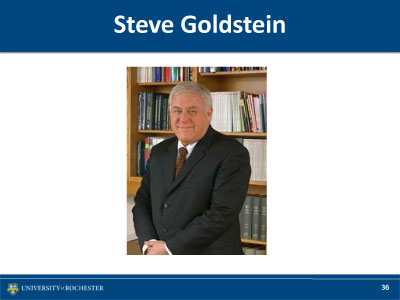
Steve Goldstein, the CEO of Strong Memorial Hospital and Highland Hospital, was named by Becker’s Hospital Review in a list of the top 40 smartest people in health care. Steve has been a national leader in health care who has provided a significant voice to federal and state health care policy debates.
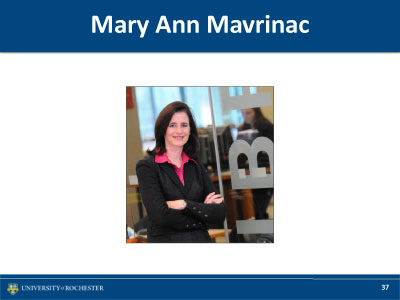
Mary Ann Mavrinac, Vice Provost and Andrew H. and Janet Dayton Neilly Dean of River Campus Libraries, was selected for the 2014 Lifetime Achievement Award from the Ontario College and University Library Association, the oldest and largest library association in Canada.
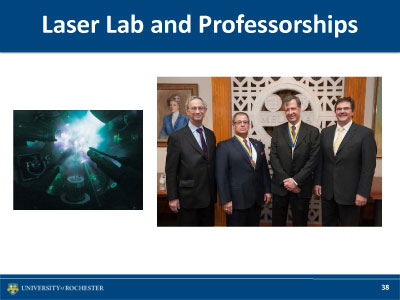
The Laboratory for Laser Energetics successfully concluded its 25,000th experiment to create and study extreme states of matter. The 25,000th experiment was designed to study the properties of liquid deuterium at high pressure, which will help scientists study how to make fusion work in the Laboratory and what is happening in the interior of giant planets such as Jupiter and Saturn. On April 3rd, we celebrated Laser Lab Director Robert McCrory’s 38 years of accomplishments by installing him in a University Professorship, simultaneously installing Professor Riccardo Betti, an internationally recognized leader in fusion energy research, in the Robert L. McCrory Professorship, an endowment which was created by an anonymous donor.
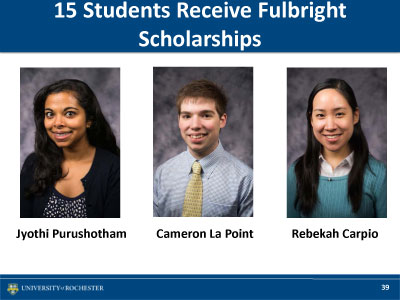
Fifteen of our students were named Fulbright Scholars, placing the University sixth in the nation when the number of Fulbright Scholarships is adjusted for the number of undergraduate students.
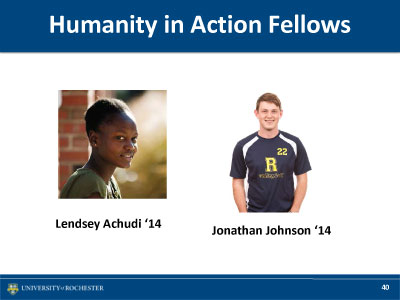
Two seniors at the University, Lendsey Achudi and Jonathan Johnson, were selected as Fellows for the 2014 Humanity in Action Fellowship.
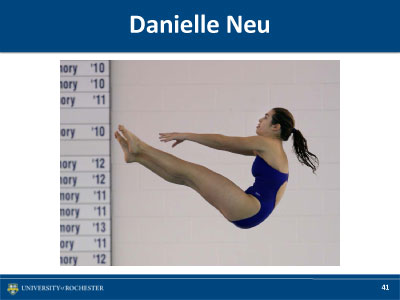
Freshman Chemical Engineering major Danielle Neu earned honorable mention All-America honors on the three-meter board at the NCAA Division III championships. She is the first women’s diving All-American at Rochester.
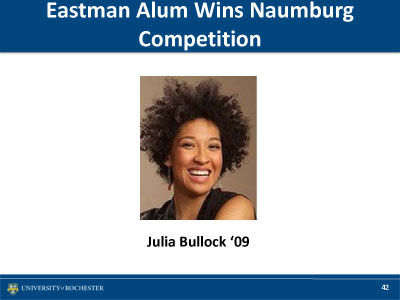
Soprano Julia Bullock, who received her Bachelor of Music degree at the Eastman School of Music in 2009, was named the winner of the Walter W. Naumburg Foundation’s International Vocal Competition following the finals in New York City on March 14. The Naumburg international competition has been described by The New York Times as “the most prestigious of them all.”
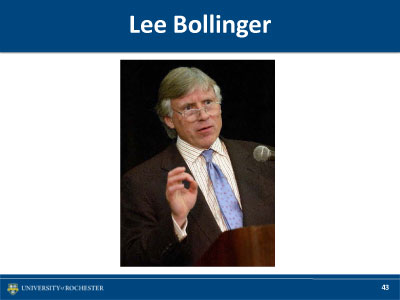
Lee Bollinger, President of Columbia University, delivered the keynote address at the University’s 2014 Diversity Conference, Crossroads: An Opportunity for Progress. Bollinger was the defendant in Grutter v. Bollinger, the United States Supreme Court case that authorized colleges and universities to take race into account in admissions decisions, recognizing the importance of diversity in higher education.
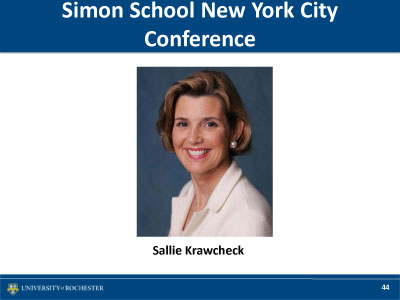
On May 8th, the annual Simon School New York City Conference will feature, among others, keynote speaker Sallie Krawcheck, President of the Global Wealth Management and Investment Division of Bank of America; Larry Kudlow, host of CNBC’s Kudlow Report; and Bob Wilmers, President of M & T Bank.
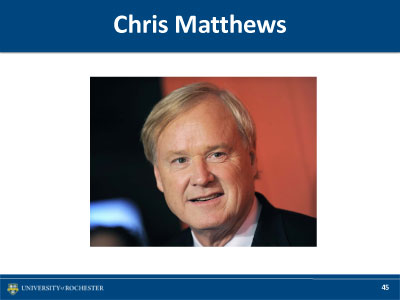
Chris Matthews will deliver the 164th commencement address at the Arts, Sciences and Engineering ceremony on May 18.
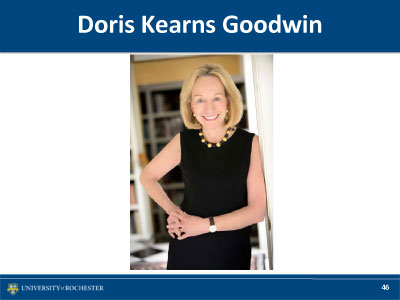
Pulitzer Prize winning historian Doris Kearns Goodwin, author of Team of Rivals, will be the keynote speaker for Meliora Weekend this October. Her latest book, The Bully Pulpit, focuses on the 1912 election and especially the relationship between former President Teddy Roosevelt and incumbent William Howard Taft.
II. SENIOR LEADERSHIP TRANSITIONS
This year we are experiencing an unusually large number of senior leadership transitions.
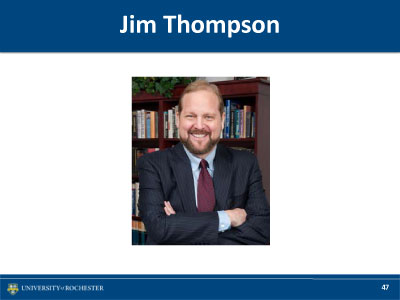
In September 2013, Chief Advancement Officer Jim Thompson began a medical leave and subsequently in February, Jim and I agreed that he would become a Special Counsel to the President to focus on strategic Advancement issues. During the past eight years, Jim achieved virtually everything that we set out to accomplish in Advancement. We will complete our $1.2 billion Meliora Challenge campaign by June 30, 2016. We have strengthened relationships with alumni, parents and friends who support our University. Jim built an outstanding Advancement program and team. Jim took the initiative in developing an ambitious strategic and implementation plan that today is ahead of schedule for virtually every area addressed in the plan, including our Annual Fund, new volunteer groups such as our National Councils and Regional Cabinets, and the Wilson Society to recognize those who make planned gifts to the University. Working with Board Development Committee Chair Larry Bloch, I am leading the search for a new Chief Advancement Officer. Let me also express my gratitude to Interim Chief Advancement Officer Jim Osterholt for his highly effective interim leadership.
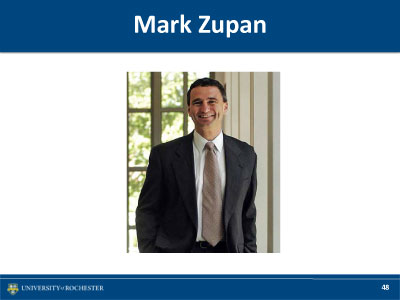
In September, Simon School Dean Mark Zupan announced that after 10 years as Dean of our business school, he would pass the baton of leadership to a new Dean on July 1, 2014. Mark has achieved an exemplary record. During his Deanship, the Simon School added nine new tenure eligible faculty and supportive alumni, friends, faculty and staff contributed nearly $64 million of the School’s $85 million target as part of the University Meliora Challenge campaign. This support has allowed the Simon School to add 10 new endowed professorships, nearly doubling the total at the School. Curricular innovations such as the M.S. in Medical Management and M.S. in Finance have resulted in strong student demand and enabled Simon consistently in recent years to achieve the University’s target 5.5 percent endowment draw. On September 17th, I announced that Mark will become the John M. Olin Distinguished Professor of Economics and Public Policy and will be Director of the Bradley Policy Research Center when he returns to the faculty. I also am chairing the Simon School Dean Search Committee.
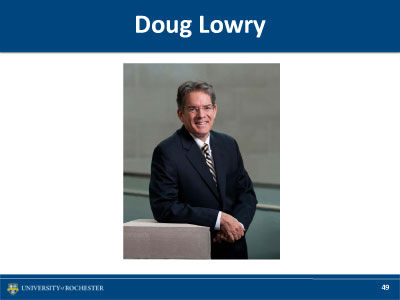
On September 23rd, Eastman School of Music Dean Doug Lowry resigned as Dean because of deteriorating health. Earlier the University Board voted to award Doug an honorary Doctor of Music degree and later voted to rename the central hallway in Eastman Theatre in Doug’s honor. Doug led the Eastman School during its renovation and expansion of Eastman Theatre; he unified the Eastman community. He hired outstanding faculty. He was, as an associate memorably stated, a polymath with a heart, who personified absolute integrity and creativity in advancing the musical arts. Doug was the rarest of academic administrators: A great dean who was also a great man. On October 2nd, we lost a dear friend when Doug Lowry died. Schubert wrote: “Some people come into our lives, leave footprints on our hearts, and we are never the same.” For me, Doug was such a person. Peter Lennie is leading the search for the next Dean of the Eastman School of Music. We have enormously benefitted from Dean Jamal Rossi’s leadership of the Eastman School after Doug’s death.
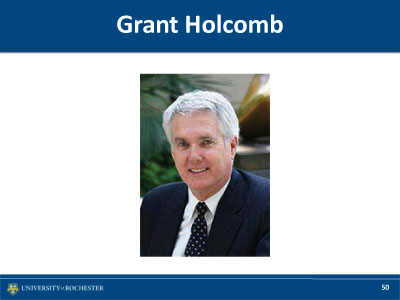
In November of 2013, Grant Holcomb, the Director of the Memorial Art Gallery, announced he

During Grant’s illustrious 29 year career, the Gallery enhanced its permanent collection, held high-profile exhibitions presenting such artists as Maxfield Parrish, Edgar Degas, Georgia O’Keeffe and Jacob Lawrence;
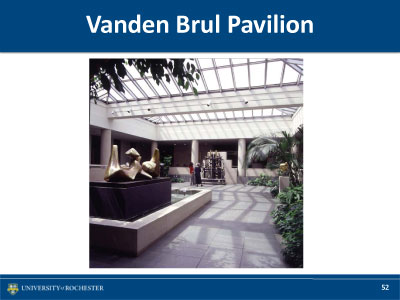
added Vanden Brul Pavilion linking the original 1913 Gallery building to Cutler Union and
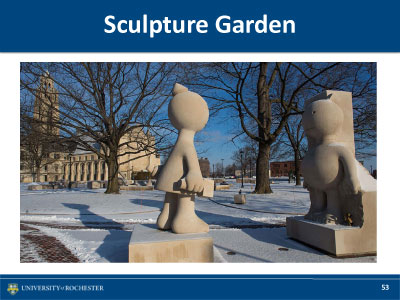
and recently completed the Centennial Sculpture Park while opening the public spaces of the MAG to the public.
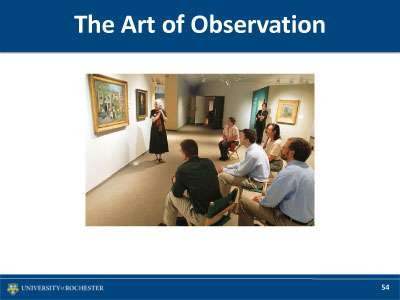
Grant has been a leader among national art gallery directors in reaching out to broader constituencies. He helped popularize the Gallery’s exceptional educational programs, worked with the University Medical Center in developing such programs as The Art of Observation and
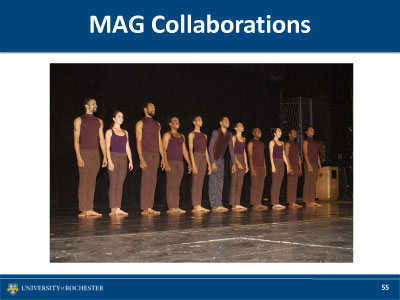
supported collaborations with, among many others, Garth Fagan Dance, George Eastman House, the Rochester Philharmonic Orchestra, Eastman School of Music and Writers and Books. MAG Board President Jim Durfee is leading a search for Grant’s successor.
III. DIVERSITY AND COMMUNITY
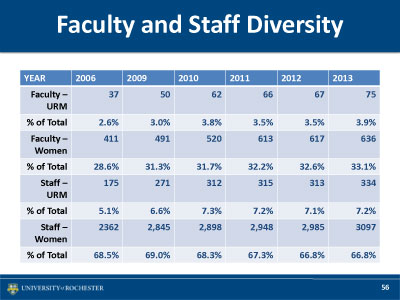
We continue to make slow but steady progress in faculty, student and staff diversity. Between 2006 and 2013, the percentage of our underrepresented minority faculty has grown from 2.6 percent to 3.9 percent, with the number of underrepresented faculty doubling from 37 to 75. During the same period, women on our faculty have increased from 28.6 percent to 33.1 percent, an increase in actual numbers from 411 to 636. Our aggregate underrepresented minority staff has increased from 5.1 percent to 7.2 percent.

Several of our recent hires are particularly noteworthy, such as School of Nursing Professor LaRon Nelson, who received his Ph.D. from Rochester in 2009. LaRon has served as Assistant Dean for Global and Community Affairs at the University of South Florida College of Nursing since 2012 and has been the principal investigator on research grants focusing on AIDS prevention and behavioral health issues. He will serve as the Associate Director of International Research in the Center for AIDS Research. He has been awarded the inaugural Dean’s Fellowship in Health Disparities.
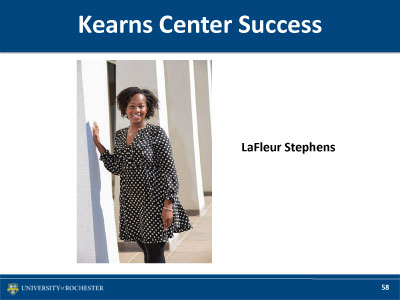
Progress in diversity is neither automatic nor simple. It takes commitment. It takes hard work. Let me offer an example of a program that we have developed at the University of Rochester that has become a national model. The David T. Kearns Center for Leadership and Diversity in Arts, Sciences and Engineering, led by Beth Olivares, Associate Dean for Diversity Initiatives and Executive Director of the Kearns Center, has a track record that impresses colleagues across the country. Among its alumni Kearns Scholars, more than 50 percent are studying for graduate degrees in Science, Technology, Engineering and Math, so called STEM fields. The Kearns Center supervises our McNair Scholars, about 85 percent of whom go to graduate school, including LaFleur Stephens, now a post-doctoral research associate at Princeton.
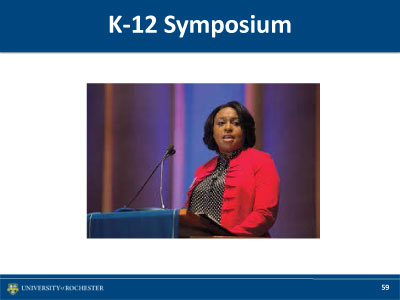
Many of the greatest social challenges in our inner cities involve race and poverty. In early February, I hosted a Presidential Symposium that focused on revitalizing K-12 education in Rochester at which Mayor Lovely Warren presented the keynote speech. The Symposium highlighted programs that work, such as the Hillside Work-Scholarship Connection that has more than doubled the graduation rates of the Rochester City School District for its students. We also are proud of the University’s Upward Bound programs, administered by our Kearns Center, that have supported nearly 300 low income area high school students in an effort to increase the number of Rochester City School District students who apply and gain admission to college. Upward Bound has a 96 percent high school graduation rate. In opening this Symposium, I stressed, “K-12 education is one of the great social challenges of the 21st century. When many universities have scaled back their support of schools of education, the University of Rochester is determined to invest in K-12 education as part of our commitment to the greater Rochester community and, most of all, its children.”
IV. COMMUNICATIONS
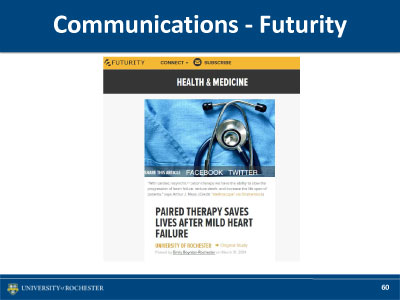
University Communications, led by Bill Murphy, has played a central role in the collaborative communications project known as Futurity. Futurity.org is edited and hosted at the University of Rochester, and co-led by Stanford, Duke, Rochester, the University of Leeds, and the University of Melbourne. The site features research news from 63 top universities in the United States, the United Kingdom, Canada and Australia, and covers newly published research in fields including health, science, technology, society, the environment, education, law, and the humanities. Ten million people have visited 15 million pages on Futurity since it launched in 2009. Futurity’s daily newsletter was featured in the Huffington Post as one of 10 newsletters that “will make you smarter.”
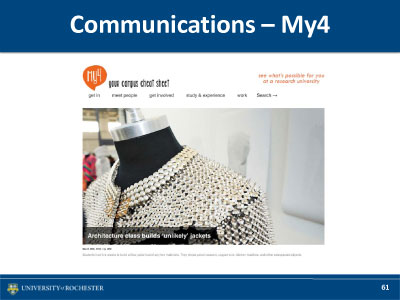
My4.org is an
experimental project, similar to Futurity, that highlights the student experience at research universities. My4 features original student profiles and advice from campus experts, as well as news about student life. The idea is to show students what is possible for them at a research university. Target audiences are teens, parents and school counselors. Today there are 23 participating universities.
V. IMPLEMENTING OUR 2013-2018 STRATEGIC PLANS
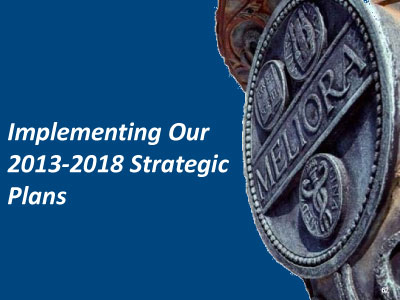
In October, the University Board of Trustees adopted a new set of University, Medical Center, and school strategic plans. We called the University Strategic Plan Aiming Higher and characterized its objectives and goals in these terms:
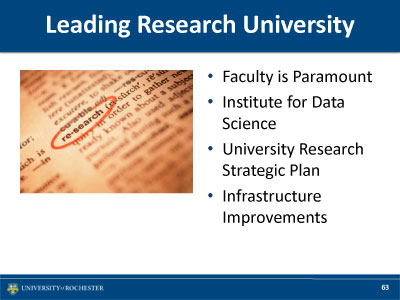
BE ONE OF THE NATION’S LEADING RESEARCH UNIVERSITIES
- Faculty
Is Paramount - Institute
for Data Science - University
Research Strategic Plan - Infrastructure
Improvements
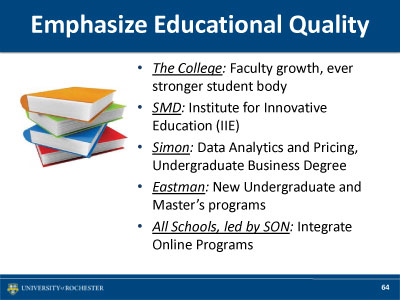
EMPHASIZE EDUCATIONAL QUALITY
- The
College – Faculty Growth, Ever Stronger Student Body - School
of Medicine and Dentistry – Institute for Innovative Education - Simon
School – Data Analytics, Pricing, Undergraduate Business - Eastman
– New Undergraduate and Master’s Programs - All
Schools – Integrate Online Programs
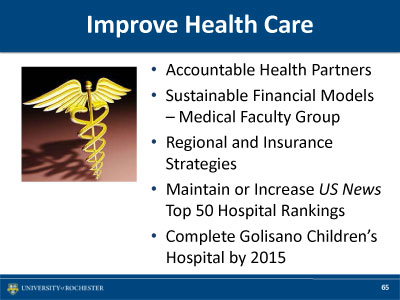
IMPROVE HEALTH CARE
- Accountable
Health Partners - Sustainable
Financial Models – Medical Faculty Group - Regional
and Insurance Strategies - Maintain
or Increase US News Top 50 Hospital
Rankings - Complete
Golisano Children’s Hospital by 2015
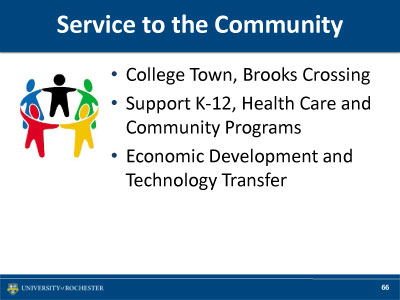
SERVICE TO THE COMMUNITY
- College
Town, Brooks Crossing - Support
K-12, Health Care and Community Programs - Economic
Development and Technology Transfer
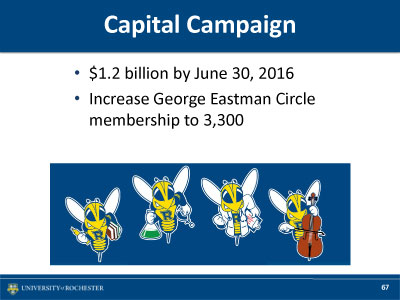
COMPLETE THE MELIORA CHALLENGE CAPITAL CAMPAIGN
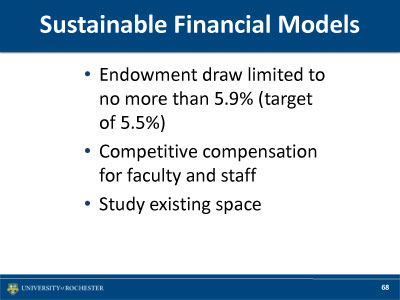
SUSTAINABLE FINANCIAL MODELS
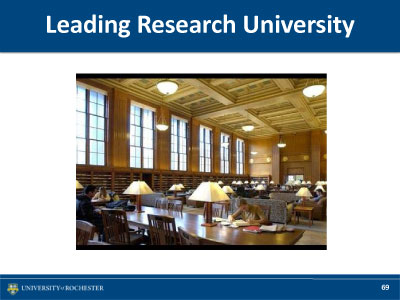
Our first University objective is to be one of this nation’s leading research universities. This objective is well aligned with what has become a critical national priority. Economists have estimated that at least 50 percent of economic growth in the United States during the last half of the 20th century was derived from technological innovation, much of which resulted from federally funded sponsored research agencies, including the National Science Foundation, the National Institutes of Health, the Department of Energy and the Department of Defense.
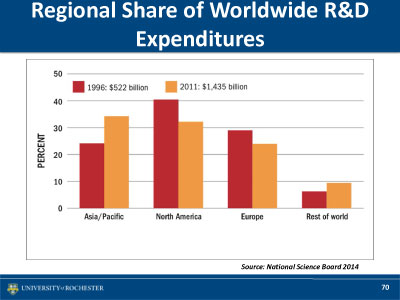
As a nation we increasingly face an innovation deficit. According to the National Science Board, the United States’ share of global Research and Development has declined from 37 percent to 30 percent since 2001. During the same period the economies of East and Southeast Asia and South Asia – including China, India, Japan, Malaysia, Singapore, South Korea and Taiwan – achieved an increase in their combined share from 25 percent to 34 percent of the global total.

The pace of growth over the past 10 years in China’s overall Research and Development has been exceptionally high at about 18 percent annually adjusted for inflation, propelling it to 14.5 percent of the global total in 2011, up from 2.2 percent in 2000. There is nothing wrong with a commitment to research by any nation – but there is a national threat in the faster rate of growth abroad than in the United States with its implications for our technological innovation and faculty and student recruitment and retention. Simply put, we seek to be the most innovative nation in the world and know that this will require the most talented faculty and students.
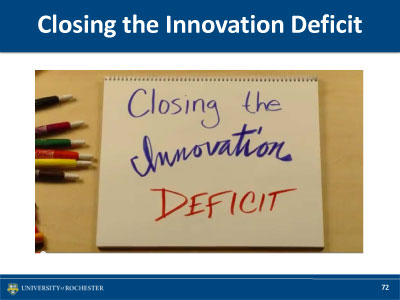
The University of Rochester is a member of the American Association of Universities, this nation’s leading organization of research universities, through which I have supported efforts by the AAU and allied organizations to address the innovation deficit. Recently, the AAU and 13 business, higher education and scientific organizations jointly urged Congress to close the innovation deficit by increasing federal investments in sponsored research. Among other steps, they have produced a short video for general audiences that I would like to share with you.
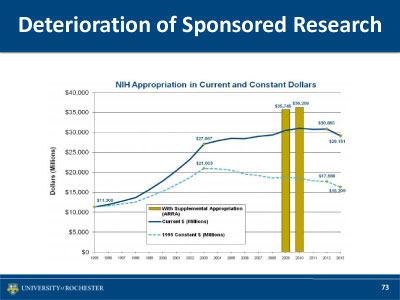
The deterioration in sponsored research has been profound at the national level. When 1995 dollars are normalized across time, research support, for example, from the National Institutes of Health increased from $11.3 billion to $21 billion between 1995 and 2003. Since 2003, however, inflation adjusted dollars for NIH have decreased from $21 billion to $16.3 billion.
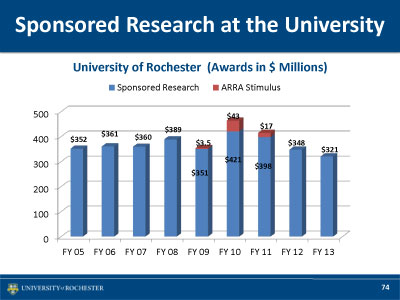
This directly affects the University of Rochester. Over the past five years, we have received nearly $2 billion in research funding and on a per faculty basis rank among the top 15 research universities in the country in sponsored research support per faculty member. During the first eight months of this fiscal year, however, research expenditures decreased from $250.3 million to $229.9 million.
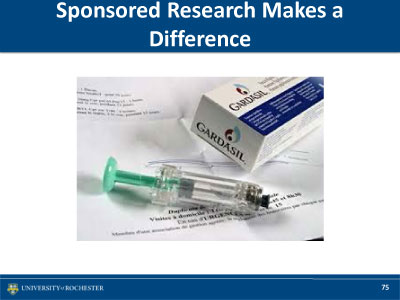
Sponsored research makes a difference. Since the work of University of Rochester Medical School Professors Bonnez, Reichman and Rose helped produce the first vaccine against any cancer, the commercialization of Gardasil has led to a reported 56 percent reduction in human papillomavirus in teenage young women, a dramatic step in reducing cervical cancer.
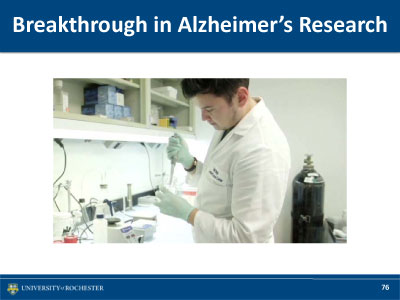
A 2014 path breaking study with University of Rochester lead author Professor Mark Mapstone published in Nature Medicine shows that a blood test can predict Alzheimer’s Disease with 90 percent accuracy. The study found that seniors with low levels of 10 particular fats or lipids were more likely to develop Alzheimer’s or other forms of cognitive dementia. These new biomarkers potentially will give doctors tools to diagnose and potentially treat or cure Alzheimer’s. Doctors estimate that one in eight of our citizens will test positive for Alzheimer’s or other forms of cognitive dementia. Few areas of research could be more vital in neuroscience today. Over the next 40 years, the number of Alzheimer’s cases may increase by approximately five-fold.
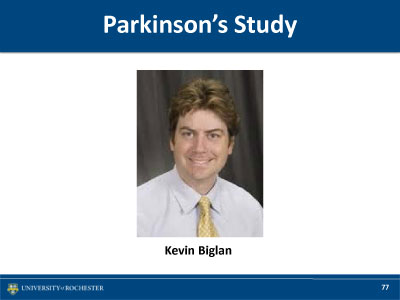
A few days ago, the National Institutes of Health awarded $23 million to a multi-site study led by University of Rochester Medical Center Neurologist Kevin Biglan to study whether a drug currently used to treat high blood pressure can slow the progression of Parkinson’s disease, the illness that is second only to Alzheimer’s in brain disease.
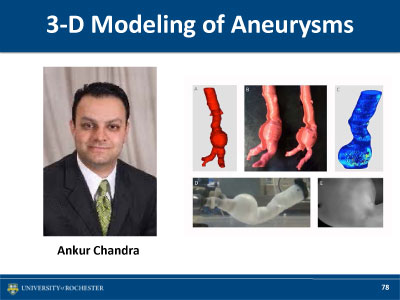
Researchers in our medical center, including Ankur Chandra, Associate Professor of Surgery and Biomedical Engineering, now are using 3-D printing to model aneurysms. The use of patient-specific 3-D models represents a genuine breakthrough in modeling aneurysm disease. Researchers will no longer invariably need to use animals or humans for experiments.
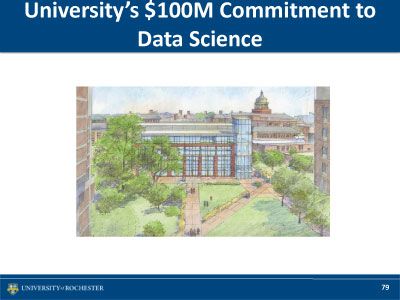
Data science is the University’s top priority for the 2013-18 strategic plans that were adopted by the Board of Trustees in October. This research field has emerged as one of the defining disciplines of the 21st century. According to IBM, every day we create 2.5 quintillion bytes of data—so much that 90 percent of the data in the world today was created in the last two years alone. The University of Rochester intends to be among the world’s leading institutions in this rapidly accelerating discipline, focusing on health threat early warning systems, reducing the cost of health care and cardiac modeling, among other specifically defined areas. Our University has committed $100 million to expand our data science initiative. We have to date spent approximately $50 million on this project thanks in part to New York State support for our Health Sciences Center for Computational Innovation, which has helped enable more than 650 faculty, students and research staff and 100 principal investigators to use our high performance computing and generated over $300 million during the past three years.
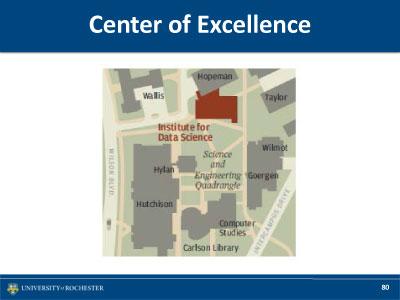
In the next five years, we intend to hire 20 new faculty in computational science and applied fields, including biostatistics, psychiatry, physics, and political science. We will also continue to acquire cutting-edge technology and build a new $25 million facility to house our Institute for Data Science. New York State in its recently enacted budget also has named our Institute for Data Science a Center of Excellence and provided in next year’s budget $872,333 for next year, with the expectation that this will continue as annual support.
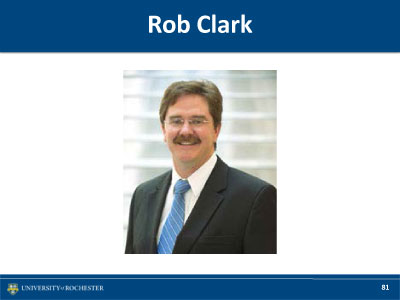
Under the Research Strategic Plan, coordinated by Senior Vice President for Research and Hajim School Dean Rob Clark, the University has developed a comprehensive approach to research, including computing, and commercialization, when appropriate, of research. Rob has established a Strategic Plan Activation and Review Committee to monitor and encourage strategic research initiatives approved by our Board.
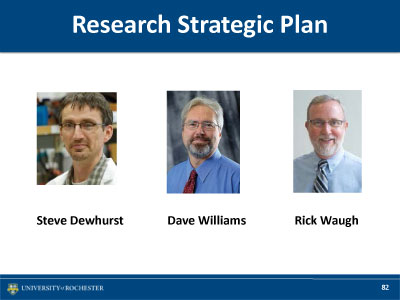
Steve Dewhurst, Vice Dean for Research in the School of Medicine and Dentistry, Dave Williams, Dean of Research in Arts, Sciences and Engineering, and Rick Waugh, Associate Vice President for Research, join Rob in the Senior Research Leadership Group.
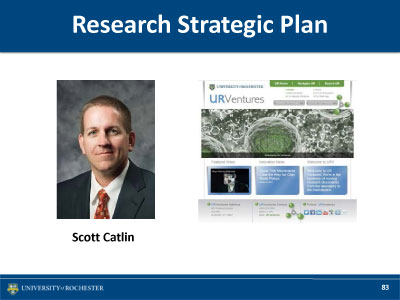
Scott Catlin in March 2013 was appointed Associate Vice President for UR Ventures. UR Ventures is charged with overseeing technology transfer and this year will particularly focus on our Technology Development Fund. A Center for Business Engagement also has been established to serve as a portal for private industry to engage with the University.
VI. NEXT YEAR’S BUDGETS
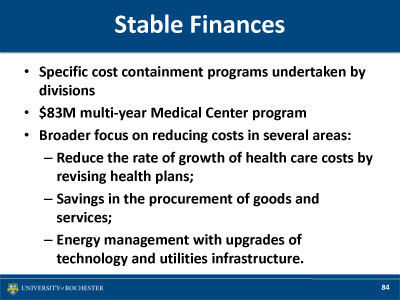
Our finances remain stable as we continue our efforts at cost containment. The Medical Center, for example, has begun an $83 million cost containment program over the next three years.
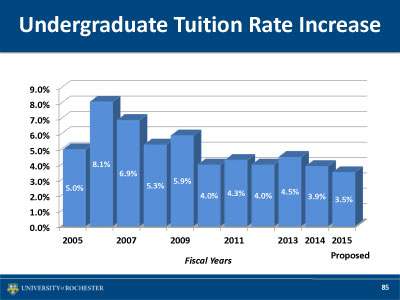
Our undergraduate tuition rate increase of 3.5 percent for next year is the lowest tuition increase in 13 years.
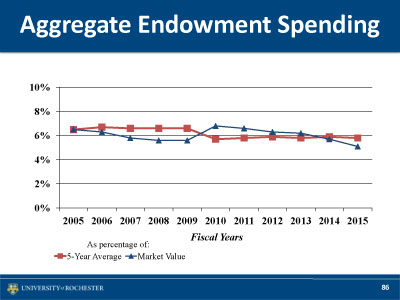
Our aggregate endowment spending rate of 5.8 percent on our five-year rolling average equals 5.1 percent of current market values, the lowest in decades and will strengthen endowment values in the future.
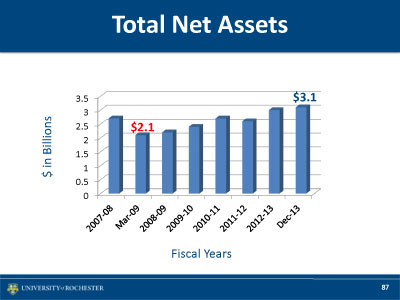
Our net assets increased by $167 million between June 30 and December 31, 2013 and for the first time in our history, we crossed the $3 billion threshold for total net assets.
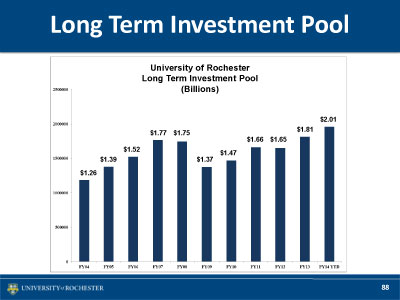
Our Long Term Investment Pool, which is largely comprised of our endowment, crossed the $2 billion threshold on February 28, 2014, the highest total that the Pool has ever achieved.

We are
succeeding in gradually strengthening our finances by running a tight ship. This is necessary in an academic world of incessant uncertainty with respect to future health care support, pressures on tuition increases, and declines in inflation adjusted dollars for federal sponsored research.

: CONCLUSION
Next year I
particularly will focus on five major University priorities:
First, complete senior
leadership searches for new Deans for the Simon and Eastman Schools, a new Chief Advancement Officer and a new Director of the Memorial Art Gallery.
Second, work on revised strategic plans for Eastman and Simon and on implementation of the Medical Center’s strategic plan.
Third, complete and open College Town.
Fourth, substantially complete construction of the new Golisano Children’s Hospital.
Fifth, support implementation of the University Research Plan with emphasis on the Institute for Data Science Building and the new Science and Engineering Quad.
In its 164-year history, the University of Rochester has weathered challenges, capitalized on opportunities and always emerged triumphant. We are strong, growing, and an increasingly complex institution that is inexorably faithful to our motto . . . Meliora . . . ever better. The University’s distinctive position among America’s great research universities is well earned. This has required dedicated and productive efforts by our distinguished faculties who are, and must always be, the University’s first priority and single most essential asset. I have the utmost confidence that the dynamic talents of our faculty, students and staff will continue to help ensure a vibrant and healthy future for the University.
